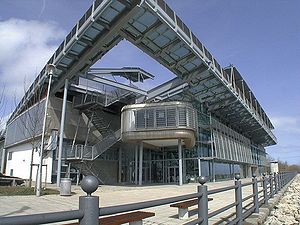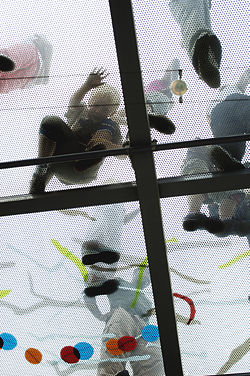
National Glass Centre
Encyclopedia

North East England
North East England is one of the nine official regions of England. It covers Northumberland, County Durham, Tyne and Wear, and Teesside . The only cities in the region are Durham, Newcastle upon Tyne and Sunderland...
.
Background
The National Glass Centre is located in MonkwearmouthMonkwearmouth
Monkwearmouth is an area of Sunderland located at the north side of the mouth of the River Wear. It was one of the three original settlements on the banks of the River Wear along with Bishopwearmouth and Sunderland, the area now known as the East End. It includes the area around St. Peter's Church...
, on the north banks of the River Wear
River Wear
The River Wear is located in North East England, rising in the Pennines and flowing eastwards, mostly through County Durham, to the North Sea at Sunderland.-Geology and history:...
, on the former site of J.L. Thompson and Sons shipyard. The centre is close to the site of St. Peter's Church, part of the original Monkwearmouth-Jarrow Priory built in 674. It was here that Benedict Biscop
Benedict Biscop
Benedict Biscop , also known as Biscop Baducing, was an Anglo-Saxon abbot and founder of Monkwearmouth-Jarrow Priory and was considered a saint after his death.-Early career:...
introduced glass making into Britain, by hiring French
France
The French Republic , The French Republic , The French Republic , (commonly known as France , is a unitary semi-presidential republic in Western Europe with several overseas territories and islands located on other continents and in the Indian, Pacific, and Atlantic oceans. Metropolitan France...
glaziers to make the windows for the priory.
The glass-making industry exploded in the eighteenth century, driven by an abundance of cheap coal
Coal
Coal is a combustible black or brownish-black sedimentary rock usually occurring in rock strata in layers or veins called coal beds or coal seams. The harder forms, such as anthracite coal, can be regarded as metamorphic rock because of later exposure to elevated temperature and pressure...
and high-quality imported sand
Sand
Sand is a naturally occurring granular material composed of finely divided rock and mineral particles.The composition of sand is highly variable, depending on the local rock sources and conditions, but the most common constituent of sand in inland continental settings and non-tropical coastal...
. Sunderland glass became known throughout the country. In later years, the Pyrex
Pyrex
Pyrex is a brand name for glassware, introduced by Corning Incorporated in 1915.Originally, Pyrex was made from borosilicate glass. In the 1940s the composition was changed for some products to tempered soda-lime glass, which is the most common form of glass used in glass bakeware in the US and has...
brand of glassware was manufactured in Sunderland. In 2007, the last two remaining glass firms in Sunderland - Corning Glass Works and Arc International
Arc International (tableware)
Arc International is a French manufacturer and distributor of household goods. The company was established in Arques, Pas-de-Calais, where it is still headquartered, as a glass-making firm under the name Verrerie des Sept Ecluses in 1825...
(who make Pyrex) - announced they would close.
Despite the decline in the industry, in 1998 the centre was opened for £17 million. It was funded by the Arts Council in conjunction with the University of Sunderland
University of Sunderland
The University of Sunderland is located in Sunderland, north east England. The university has more than 17,500 students, including 7,000-plus international students from some 70 countries....
, Tyne and Wear Development Corporation
Tyne and Wear Development Corporation
The Tyne and Wear Development Corporation was established in 1987 to develop land on the banks of the River Tyne and the River Wear in England. Its flagship developments included the regeneration of the East Quayside in Newcastle, Royal Quays in North Tyneside and St Peter's in Sunderland. During...
, European Regional Development Fund and Sunderland City Council. The centre, located alongside the university's St. Peter's campus, continued the regeneration of the banks of the Wear.
Experience

Glass
Glass is an amorphous solid material. Glasses are typically brittle and optically transparent.The most familiar type of glass, used for centuries in windows and drinking vessels, is soda-lime glass, composed of about 75% silica plus Na2O, CaO, and several minor additives...
and steel
Steel
Steel is an alloy that consists mostly of iron and has a carbon content between 0.2% and 2.1% by weight, depending on the grade. Carbon is the most common alloying material for iron, but various other alloying elements are used, such as manganese, chromium, vanadium, and tungsten...
. It has a glass roof that people can walk around and look down into the centre below. There is a total of 3,250 square metres of glass on the roof, and it can hold 4,600 people on at any one time. Each glass panel on the roof is 6 cm thick.
The centre is a museum
Museum
A museum is an institution that cares for a collection of artifacts and other objects of scientific, artistic, cultural, or historical importance and makes them available for public viewing through exhibits that may be permanent or temporary. Most large museums are located in major cities...
dedicated to the history of glass-making, with numerous exhibitions and galleries. Visitors can also watch glass being made in the centre.
A number of artist
Artist
An artist is a person engaged in one or more of any of a broad spectrum of activities related to creating art, practicing the arts and/or demonstrating an art. The common usage in both everyday speech and academic discourse is a practitioner in the visual arts only...
s are located on site, and their work can be purchased by visitors in the glass shop.
Since August 2006, National Glass Centre dropped its admission fee and is currently free to visit. Since the drop in admission fee, the centre has seen a rapid increase in visitors. It has also played host to many prestigious events including the 2007 North East Tourism Awards and T4
T4 (Channel 4)
T4 is a scheduling slot on Channel 4 from about 09:00 until 14:00 on Saturdays and 17:00 on Sundays. It also airs on weekdays in the school holidays. The slot has a separate station identification on screen graphic from Channel 4 and E4. The logo of T4 is noticeably the top right segment of the...
Transmission with T-Mobile.
Financial trouble and criticism
Since the centre opened it has failed to meet targets on visitor numbers. Visitor numbers of 100,000 per year were some way short of the target of 250,000 visitors per year.The centre receives regular funding from the Arts Council England - including one of £700,000 - prompting a National Audit Office report to judge that it was "over-funded". Despite this, the site continues to receive a quarter of a million pound grant annually by the Arts Council and the City Council and in 2002 was losing £100,000 per year. The problems of low attendance and overly optimistic income generation the Centre experienced have been shared by other lottery funded cultural attractions in the North East such at the Arc Centre in Stockton
Stockton-on-Tees
Stockton-on-Tees is a market town in north east England. It is the major settlement in the unitary authority and borough of Stockton-on-Tees. For ceremonial purposes, the borough is split between County Durham and North Yorkshire as it also incorporates a number of smaller towns including...
(which went into liquidation in 2003) and nearby Baltic Centre for Contemporary Art
BALTIC Centre for Contemporary Art
The Baltic Centre for Contemporary Art is an international centre for contemporary art located on the south bank of the River Tyne alongside the Gateshead Millennium Bridge in Gateshead, North East England, United Kingdom...
.
Exhibitions
The National Glass Centre hosts a variety of changing exhibitionsArt exhibition
Art exhibitions are traditionally the space in which art objects meet an audience. The exhibit is universally understood to be for some temporary period unless, as is rarely true, it is stated to be a "permanent exhibition". In American English, they may be called "exhibit", "exposition" or...
in its Contemporary Gallery
Contemporary art gallery
A contemporary art gallery is a place where contemporary art is shown for exhibition and/or for sale. The term "art gallery" is commonly used to mean art museum , the rooms displaying art in any museum, or in the original sense, of any large or long room.-Identity, function and locality:A...
. Exhibitions have included:
Connection to Place - Tim Shaw June - August 2010
Beautifully Crafted - 25 September 2008 - 22 February 2009
The Dark Glass - 6 - 28 September 2008
Art Forms from the Ocean - 11 April - 31 August 2008
Neon
Neon
Neon is the chemical element that has the symbol Ne and an atomic number of 10. Although a very common element in the universe, it is rare on Earth. A colorless, inert noble gas under standard conditions, neon gives a distinct reddish-orange glow when used in either low-voltage neon glow lamps or...
- 1 December 2007 - 24 March 2008
One-off Factory, featuring Mathias Bengtsson and Anne Vibeke Mou - 6 October - 18 November 2007
North + South - 1 July - 23 September 2007
Lynette Wallworth - 17 March - 17 June 2007
Snowdomes - 25 November 2006 - 4 March 2007
Lybensky & Brychtova (What then Shall we Choose? Weight or Lightness?) - 17 July - 12 November 2006
Wearing Glass - 12 May - 9 July 2006
Trip the Light Fantastic - 10 February - 30 April 2006

